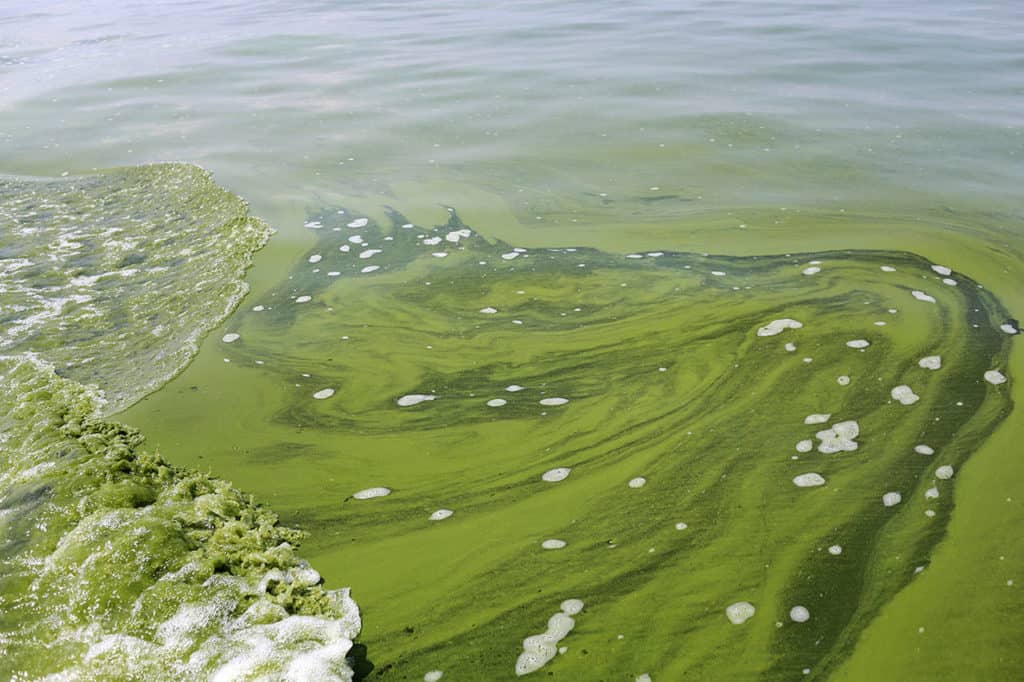
Harmful Algal Blooms and Our Water.
As farmers and land-dwellers, our livelihoods are directly and intimately affected by water. Of course, as humans, we know our life depends on it, as well. But as land-stewards, it is important that we regularly assess how we treat the soil, because our livelihood depends on it as well.
Land use and its effects intersect in our local region, within the Cayuga Lake watershed (e.g. Ithaca, NY), and other surrounding Finger Lakes. All of us live in a watershed, which means what we do on our land affects the watershed – and water within the entire network of ponds, streams, wetlands, creeks, lakes eventually ends up in a large body of water. The Finger Lakes Region is largely part of either the Great Lakes Water Basin or the Chesapeake Watershed, and what we do to the land which we tend, affects not only our smaller local lakes, but the Great Lakes and the Atlantic Ocean via Chesapeake Bay.
The last few years we have become more closely acquainted with the words “Harmful Algal Blooms” or “HABS”, cyanobacteria, and maybe even possibly “nutrient pollution.” HAB’s have been limiting our summer swims, our lake outings, and its largely understood that they can be deadly for our pets, young children, cause skin lesions and harm many other life forms. Being a region so connected to our lakes, this affects our quality of life. With the frequency and number of HABS happening in our region, it should be a large concern for everybody. So why do we get Harmful Algal Blooms? Do we have the power to make change? Should you even care about Harmful Algal Blooms?
Harmful Algal Blooms are a symptom of a much bigger issue: Nutrient Pollution. Nutrient pollution is “caused by excess phosphorus and nitrogen in the air and water. Nitrogen and phosphorus are nutrients that are natural parts of aquatic ecosystems. Nitrogen is also the most abundant element in the air we breathe. Nitrogen and phosphorus support the growth of algae and aquatic plants, which provide food and habitat for fish, shellfish and smaller organisms that live in water.” When we have too much of these, it sets off necessary balances in our environment that are necessary for human life.
Currently, agriculture plays a large role in this imbalance because many large-scale or factory farms apply herbicides, insecticides and large amounts of fertilizers that offset the nutrient balance. When this happens, it seeps from the soil surface and leaches down into the watershed, down the roads in a large rain event, and enters the waterways.
I write all of this as a conversation I don’t hear often enough in our farming communities: the importance of taking care of our water, and what water really means to all of life. Water is the basic living structure of all things on this planet, including the planet itself. By this time now, it’s no longer part of the script to say “if we don’t take care of it, we won’t have it” – we’ve entered into a new era where life as we know it is under threat.
One step that can affect so much is being mindful of the nutrients we and/or livestock are putting into our soils, and how much we are using. There are techniques like companion planting, diversified crop plantings, low/no-till, cover-cropping, on-site composting, and other forms of regenerative practices that indigenous and black farmers have used for years, that have proved sustainable in the longer term. These techniques amongst others are useful in smaller farming practices, and also demonstrates why large farm corporations are likely un-sustainable. It’s time to ask questions about what we can do. These harmful algal blooms are only a symptom of a much, much larger problem. In the midwest, where corporate agriculture is very prominent, the nutrient pollution has affected all life down in the Gulf of Mexico, and the coastline all around the gulf, through the Mississippi River.
Farmers and land-stewards can positively alter the environment through mindful and regenerative farming practices, so long as we also take on the challenge of changing our way of thinking around our capitalist and material economy.
